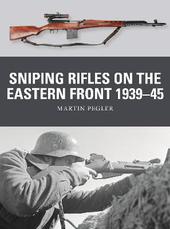
|
Sniping Rifles on the Eastern Front 1939-45
Paperback / softback
Main Details
| Title |
Sniping Rifles on the Eastern Front 1939-45
|
| Authors and Contributors |
By (author) Martin Pegler
|
|
Illustrated by Alan Gilliland
|
|
Illustrated by Johnny Shumate
|
| Series | Weapon |
|---|
| Physical Properties |
| Format:Paperback / softback | | Pages:80 | | Dimensions(mm): Height 248,Width 184 |
|
| Category/Genre | Military history
Second world war
Militaria, arms and armour |
|---|
| ISBN/Barcode |
9781472825896
|
| Classifications | Dewey:623.4425 |
|---|
| Audience | | General | | Professional & Vocational | |
|---|
|
Publishing Details |
| Publisher |
Bloomsbury Publishing PLC
|
| Imprint |
Osprey Publishing
|
| Publication Date |
21 March 2019 |
| Publication Country |
United Kingdom
|
Description
The Soviet Union had developed a significant sniping force by 1939, but the extraordinary skill and cunning displayed by Finnish snipers during the Winter War forced the Soviets to innovate. On the other side, German sniping suffered from a lack of standardization of weapons and a lack of marksmen deployed at the start of the Great Patriotic War (1941-45). There were few heroes in the conflict, but on both sides, the snipers were idolized - especially on the Soviet side, gaining almost mythical status. As well as traditional bolt-action weapons, both sides used several types of semi-automatic rifle, such as the SVT-38 and the Gew 41. Offering greater firepower at the expense of long-range accuracy, such weapons would be profoundly influential in the postwar world. Fully illustrated, this absorbing study investigates the development of sniping weapons and techniques on World War II's Eastern Front.
Author Biography
Martin Pegler is a former Senior Curator of Firearms at the Royal Armouries Museum, Leeds. He is currently a firearms consultant and has written a number of articles and books, many for Osprey. He lives in France. Johnny Shumate works as a freelance illustrator living in Nashville, Tennessee. He began his career in 1987 after graduating from Austin Peay State University. Most of his work is rendered in Adobe Photoshop using a Cintiq monitor. His greatest influences are Angus McBride, Don Troiani, and Edouard Detaille. Born in Malaya in 1949, Alan Gilliland studied photography/film and architecture, and spent 18 years as the graphics editor of the Daily Telegraph. He now writes, illustrates and publishes fiction as well as illustrating for a variety of publishers. He lives in Lincolnshire, UK.
|